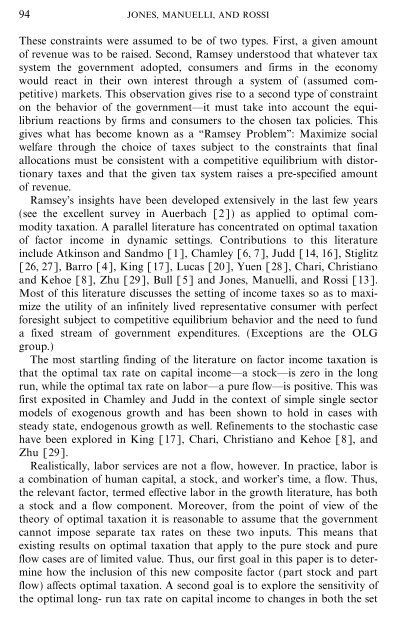On the Optimal Taxation of Capital Income
On the Optimal Taxation of Capital Income
On the Optimal Taxation of Capital Income
Create successful ePaper yourself
Turn your PDF publications into a flip-book with our unique Google optimized e-Paper software.
94 JONES, MANUELLI, AND ROSSI<br />
These constraints were assumed to be <strong>of</strong> two types. First, a given amount<br />
<strong>of</strong> revenue was to be raised. Second, Ramsey understood that whatever tax<br />
system <strong>the</strong> government adopted, consumers and firms in <strong>the</strong> economy<br />
would react in <strong>the</strong>ir own interest through a system <strong>of</strong> (assumed competitive)<br />
markets. This observation gives rise to a second type <strong>of</strong> constraint<br />
on <strong>the</strong> behavior <strong>of</strong> <strong>the</strong> government it must take into account <strong>the</strong> equilibrium<br />
reactions by firms and consumers to <strong>the</strong> chosen tax policies. This<br />
gives what has become known as a ``Ramsey Problem'': Maximize social<br />
welfare through <strong>the</strong> choice <strong>of</strong> taxes subject to <strong>the</strong> constraints that final<br />
allocations must be consistent with a competitive equilibrium with distortionary<br />
taxes and that <strong>the</strong> given tax system raises a pre-specified amount<br />
<strong>of</strong> revenue.<br />
Ramsey's insights have been developed extensively in <strong>the</strong> last few years<br />
(see <strong>the</strong> excellent survey in Auerbach [2]) as applied to optimal commodity<br />
taxation. A parallel literature has concentrated on optimal taxation<br />
<strong>of</strong> factor income in dynamic settings. Contributions to this literature<br />
include Atkinson and Sandmo [1], Chamley [6, 7], Judd [14, 16], Stiglitz<br />
[26, 27], Barro [4], King [17], Lucas [20], Yuen [28], Chari, Christiano<br />
and Kehoe [8], Zhu [29], Bull [5] and Jones, Manuelli, and Rossi [13].<br />
Most <strong>of</strong> this literature discusses <strong>the</strong> setting <strong>of</strong> income taxes so as to maximize<br />
<strong>the</strong> utility <strong>of</strong> an infinitely lived representative consumer with perfect<br />
foresight subject to competitive equilibrium behavior and <strong>the</strong> need to fund<br />
a fixed stream <strong>of</strong> government expenditures. (Exceptions are <strong>the</strong> OLG<br />
group.)<br />
The most startling finding <strong>of</strong> <strong>the</strong> literature on factor income taxation is<br />
that <strong>the</strong> optimal tax rate on capital income a stock is zero in <strong>the</strong> long<br />
run, while <strong>the</strong> optimal tax rate on labor a pure flow is positive. This was<br />
first exposited in Chamley and Judd in <strong>the</strong> context <strong>of</strong> simple single sector<br />
models <strong>of</strong> exogenous growth and has been shown to hold in cases with<br />
steady state, endogenous growth as well. Refinements to <strong>the</strong> stochastic case<br />
have been explored in King [17], Chari, Christiano and Kehoe [8], and<br />
Zhu [29].<br />
Realistically, labor services are not a flow, however. In practice, labor is<br />
a combination <strong>of</strong> human capital, a stock, and worker's time, a flow. Thus,<br />
<strong>the</strong> relevant factor, termed effective labor in <strong>the</strong> growth literature, has both<br />
a stock and a flow component. Moreover, from <strong>the</strong> point <strong>of</strong> view <strong>of</strong> <strong>the</strong><br />
<strong>the</strong>ory <strong>of</strong> optimal taxation it is reasonable to assume that <strong>the</strong> government<br />
cannot impose separate tax rates on <strong>the</strong>se two inputs. This means that<br />
existing results on optimal taxation that apply to <strong>the</strong> pure stock and pure<br />
flow cases are <strong>of</strong> limited value. Thus, our first goal in this paper is to determine<br />
how <strong>the</strong> inclusion <strong>of</strong> this new composite factor (part stock and part<br />
flow) affects optimal taxation. A second goal is to explore <strong>the</strong> sensitivity <strong>of</strong><br />
<strong>the</strong> optimal long- run tax rate on capital income to changes in both <strong>the</strong> set
















